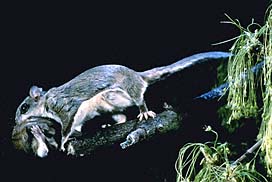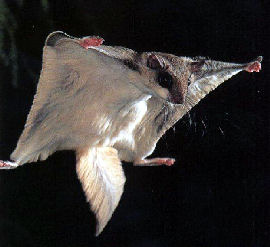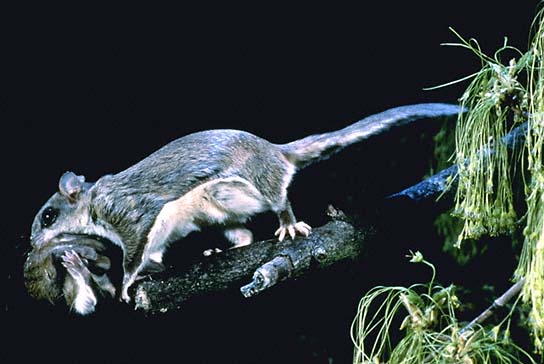Chipmunks, Squirrels, and Prairie Dogs
Description:
A very small squirrel. Very silky coat grayish brown above, white below, with hairs all white from tip to base. Loose fold of skin between foreleg and hindleg. Flattened, gray-brown tail. Large black eyes. L 7 3/4–10 1/8" (198–255 mm); T 3 1/8–4 3/4" (81–120 mm); HF 7/8–1 1/4" (22–32 mm); Wt 1 1/2–3 1/8 oz (45–90 g).
Similar Species:
Slightly larger Northern Flying Squirrel is a richer brown, with abdominal fur usually gray at base.
Discussion:
The flying squirrels are the only nocturnal tree squirrels. Although it is active in all seasons, the Southern Flying Squirrel may remain in its nest in very cold weather and will enter torpor in times of extreme cold or food scarcity. The state of torpor is not as deep as true hibernation, but the animal’s body temperature can drop to 22°F (–6°C), and it may take up to 40 minutes to wake. The flying squirrel does not truly fly, but glides through the air, up to 80 yards (meters) or more, from the top of one tree down to the trunk of another. It flies with its legs outstretched and the fold of skin between foreleg and hindleg acting as a combination parachute and sail (or glider wing). While gliding, it can turn or change its angle of descent. Just before landing, it drops its tail and lifts its forequarters, slackening the flight skin, which then serves as an air brake. It lands very lightly on all four feet, and at once scurries around to the other side of the tree trunk, in case a predator has followed its flight. Agile and extremely surefooted aloft, it is relatively clumsy on the ground. The most carnivorous of the tree squirrels, the Southern Flying Squirrel feeds on nuts, acorns, seeds, berries, fungi, lichens, birds and their nestlings and eggs, some insects, and sometimes other vertebrates, including carrion. Hard parts and wings of larger insects are often discarded. Flying squirrels will gnaw bark from maple trees and drink the sap, and also eat moths that come to the sap to feed. Great quantities of nuts, acorns, and seeds are stored for winter use, in tree hollows, in their nests, in crotches or cracks in trees, and in the ground. Hickory nuts and acorns may be buried throughout the home range, adding to the general store of nuts buried by other species of squirrels. Southern Flying Squirrels may store up to 15,000 nuts in a season. They use their front incisors to pound the nuts into the ground or a crack in a tree. Woodpecker holes are favored nest sites, but the Southern Flying Squirrel may build a summer nest of leaves, twigs, and bark that is similar to that of gray or fox squirrels, but is only about 8 inches (200 mm) in diameter. Typical dens are dead tree stubs 8 to 20 feet (2.5–6 m) high that contain woodpecker holes, 1 1/2 to 2 inches (40–50 mm) in diameter. The nest cavity is lined with shredded bark or, in the Deep South, Spanish moss and palmetto fibers. There is often a primary nest, plus many secondary nests used for temporary shelter. Some dens are used exclusively for defecation; over time, humus can build up to 1 1/2 feet (half a meter) deep. In winter, several individuals may den together in one tree hole, as their combined body heat brings up the den temperature; as many as 50 individuals have been found in one nest in winter. Flying squirrels know their home range very well, and when abroad will hide in a hollow tree, under loose bark, or another convenient spot, such as an old bird or squirrel nest. The Southern Flying Squirrel mates in early spring. The female is receptive for just one day. She usually mates with the dominant male, and often a subordinate as well. At about four weeks of age the young resemble adults; at five weeks, they exit the nest to take solid food. Females of this species defend their young vigorously, and will move them to another nest if danger threatens. The main calls of adults are faint and bird-like notes, described as similar to those of night-migrating birds. The young produce squeaks, which include ultrasonic components. One researcher listened to ultrasonic sounds on a bat detector of a female and its young as the two became reunited after both hit a bat net (only the young became entangled). The Southern Flying Squirrel is more aggressive than its northern counterpart. Predators include owls and many mammals, but the house cat is the most dangerous.




